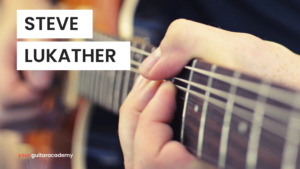Want to learn to play guitar like David Gilmour?
Want to learn to play like David Gilmour of Pink Floyd?
With the David Gilmour Player study, you’ll be “Learning to Fly” by learning his signature use of bends, vibrato, double note rhythms and minor scale notes.
Background
David Gilmour joined English rock band Pink Floyd as guitarist and co-vocalist in 1967, just before founding member Syd Barrett left. From a young age, Gilmour’s parents encouraged his passion for music, and Gilmour was inspired by artists like Elvis Presley, The Everly Brothers, and Bill Haley. According to a 2008 biography, Gilmour taught himself to play guitar using a record set and book by Pete Seeger. He met Barrett and fellow future Pink Floyd bandmate Roger Waters at 11. The boys attended different schools on the same road. He practiced guitar at lunchtime with Barrett.
In 1962, Gilmour joined a blues band called “Jokers Wild”. They recorded an album of which only 50 copies were made. Gilmour busked around Spain and France with Barrett and some other friends in 1965. With very little money, the boys were arrested at one point, and Gilmour had to go to the hospital at one point for malnutrition. In 1967, Gilmour traveled to France with two of his “Jokers Wild” bandmates, performing under the names “Flowers” and “Bullitt”. The group was not financially successful, although Gilmour contributed vocals for two songs on the Brigette Bardot film Two Weeks in September. When the band got back to England later that year, they were so strapped for cash that they had to push their tour bus.
Style
Gilmour’s playing style has been described as a link between Jimi Hendrix and Eddie Van Halen. He welds electric blues and rock guitar techniques in his playing, which utilizes vibrato with a whammy bar, string bending, and use of scales and arpeggios. In addition to guitar, Gilour plays bass, keyboards, banjo, lap steel, mandolin, harmonica, drums, and saxophone.
Legacy and awards
Gilmour continued to play with Pink Floyd after Roger Waters left the band in 1985. He has also released four solo albums, was inducted into the U.S and U.K. Rock and Roll Hall of Fames, and was made a Commander of the Order of the British empire. He has also produced several artists including Dream Academy.
The Kate Bush connection
English singer Kate Bush enjoyed a new surge of popularity in 2022 after her 1985 song “Running Up That Hill (A Deal With God)” went viral, thanks to being used in the soundtrack for Stranger Things Part. 4. Gilmour is often credited with bringing Bush into the public eye. In the 1970s, he received a mixtape by the then 16-year-old Bush from a family friend, and paid for her to professionally record three demo tracks. He also arranged for the EMI executive who signed Bush to hear the tape.
Once you learn Gilmour’s signature style, you can test drive it with Pink Floyd lessons on the Fret Zealot app!
Comfortably Numb

Gilmour wrote the music for one of Pink Floyd’s most recognizable songs, and Roger Waters wrote the lyrics. The song is part of their concept album The Wall (released in 1979) and was inspired by Waters being injected with a muscle relaxant to help with hepatitis symptoms before a show.
Wish You Were Here

The original album version of “Wish You Were Here” switches from the previous track, “Have a Cigar”, as if it was played on a radio switching from station to station, including a snippet of classical music and a radio play between tracks. The audio was recorded from Gilmour’s car radio. Gilmour then plays the intro on a 12-string guitar and overdubs another acoustic guitar solo. The part is mixed to sound like someone is playing guitar with the radio.

















